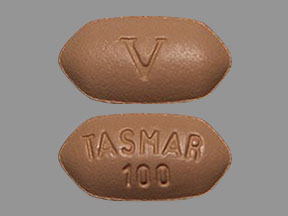Tasmar Dosage
Generic name: Tolcapone 100mg
Dosage form: tablet, film coated
Drug class: Dopaminergic antiparkinsonism agents
Medically reviewed by Drugs.com. Last updated on Sep 22, 2023.
Because of the risk of potentially fatal, acute fulminant liver failure, TASMAR (tolcapone) should ordinarily be used in patients with Parkinson's disease on l-dopa/carbidopa who are experiencing symptom fluctuations and are not responding satisfactorily to or are not appropriate candidates for other adjunctive therapies (see INDICATIONS and DOSAGE AND ADMINISTRATION sections).
BECAUSE OF THE RISK OF LIVER INJURY AND BECAUSE TASMAR WHEN IT IS EFFECTIVE PROVIDES AN OBSERVABLE SYMPTOMATIC BENEFIT, THE PATIENT WHO FAILS TO SHOW SUBSTANTIAL CLINICAL BENEFIT WITHIN 3 WEEKS OF INITIATION OF TREATMENT, SHOULD BE WITHDRAWN FROM TASMAR.
TASMAR therapy should not be initiated if the patient exhibits clinical evidence of liver disease or two SGPT/ALT or SGOT/AST values greater than the upper limit of normal. Patients with severe dyskinesia or dystonia should be treated with caution (see PRECAUTIONS: Rhabdomyolysis).
Patients who develop evidence of hepatocellular injury while on TASMAR and are withdrawn from the drug for any reason may be at increased risk for liver injury if TASMAR is reintroduced. These patients should not ordinarily be considered for retreatment with TASMAR.
Only prescribe TASMAR for patients taking concomitant carbidopa levodopa therapy. The initial dose of TASMAR is always 100 mg three times per day. The recommended daily dose of TASMAR is also 100 mg tid. In clinical trials, elevations in ALT occurred more frequently at the dose of 200 mg tid. While it is unknown whether the risk of acute fulminant liver failure is increased at the 200-mg dose, it would be prudent to use 200 mg only if the anticipated incremental clinical benefit is justified (see BOXED WARNING, WARNINGS, andPRECAUTIONS: Laboratory Tests). If a patient fails to show the expected incremental benefit on the 200-mg dose after a total of 3 weeks of treatment (regardless of dose), TASMAR should be discontinued.
In clinical trials, the first dose of the day of TASMAR was always taken together with the first dose of the day of levodopa/carbidopa, and the subsequent doses of TASMAR were given approximately 6 and 12 hours later.
In clinical trials, the majority of patients required a decrease in their daily levodopa dose if their daily dose of levodopa was >600 mg or if patients had moderate or severe dyskinesias before beginning treatment.
To optimize an individual patient's response, reductions in daily levodopa dose may be necessary. In clinical trials, the average reduction in daily levodopa dose was about 30% in those patients requiring a levodopa dose reduction. (Greater than 70% of patients with levodopa doses above 600 mg daily required such a reduction.)
TASMAR can be combined with both the immediate and sustained release formulations of levodopa/carbidopa.
TASMAR may be taken with or without food (see CLINICAL PHARMACOLOGY).
Patients With Impaired Hepatic Function:
TASMAR therapy should not be initiated in any patient with liver disease or two SGPT/ALT or SGOT/AST values greater than the upper limit of normal. (see BOXED WARNING, WARNINGS, andCLINICAL PHARMACOLOGY.)
Patients With Impaired Renal Function:
No dose adjustment of TASMAR is recommended for patients with mild to moderate renal impairment. However, patients with severe renal impairment should be treated with caution. The safety of tolcapone has not been examined in subjects who had creatinine clearance less than 25 mL/min (see CLINICAL PHARMACOLOGY).
Withdrawing Patients From TASMAR:
As with any dopaminergic drug, withdrawal or abrupt reduction in the TASMAR dose may lead to emergence of signs and symptoms of Parkinson's disease or Hyperpyrexia and Confusion, a syndrome complex resembling the neuroleptic malignant syndrome (see PRECAUTIONS: Events Reported With Dopaminergic Therapy). If a decision is made to discontinue treatment with TASMAR, then it is recommended to closely monitor the patient and adjust other dopaminergic treatments as needed. This syndrome should be considered in the differential diagnosis for any patient who develops a high fever or severe rigidity. Tapering TASMAR has not been systematically evaluated. As the duration of COMT inhibition with TASMAR is generally 5 to 6 hours on average, decreasing the frequency of dosage to twice or once a day may not in itself prevent withdrawal effects.
More about Tasmar (tolcapone)
- Check interactions
- Compare alternatives
- Pricing & coupons
- Drug images
- Side effects
- During pregnancy
- Generic availability
- Drug class: dopaminergic antiparkinsonism agents
- Breastfeeding
- En español
Patient resources
Professional resources
Related treatment guides
Further information
Always consult your healthcare provider to ensure the information displayed on this page applies to your personal circumstances.


